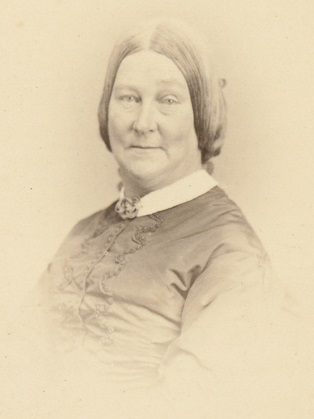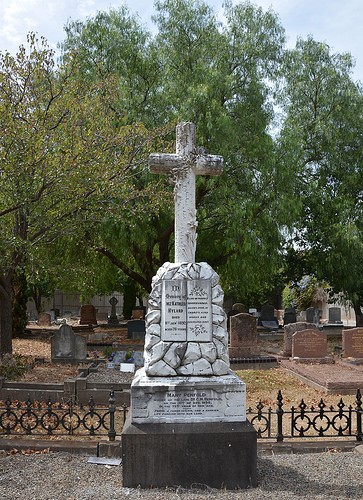Penfold, Mary
Mary Penfold (nee Holt), was born 1816 in England, daughter of physician Dr. Julius Holt and his wife.
Not a lot is recorded about Mary’s early life other than the fact that she married Dr Christopher Penfold when she was only 15. While Mary was a beloved and privileged only child and had received every advantage in the way of education and upbringing, Christopher was a member of a struggling family of thirteen children. His father was the hard-working vicar of the Sussex village of Steyning, only 16 kilometres from Brighton, where Christopher eventually went into medical practice. Although books and education were greatly valued at Steyning Vicarage, there could never have been much money from a vicar's meagre stipend for Christopher's expensive medical books and living expenses when he was studying at the prestigious St Bartholomew's Hospital Medical School. Perhaps Christopher Penfold wished to become a specialist, but the first years of hospital medicine were unpaid and young medical residents worked there for the honour of post-graduate study under a famous consultant1.

Mary Penfold circa 1869 | State Library of South Australia | B22970
Mary Penfold emigrated to Australia with her husband, a physician and four-year-old daughter Georgina arriving in the fledging colony of South Australia on 18 June, 1844 aboard the barque Taglioni. One of the reasons that the family emigrated was due to a financial dispute between Christopher Penfold and his brother Thomas. Also accompanying them was their employee Ellen Timbrell who is recorded to have served not only as the family’s maid and Georgina’s nurse, but also as assistant winemaker2.
Mary’s letters were not preserved; therefore, one source of information is from her mother’s letters to Mary:
“’The wind blew in gales and our days and nights were spent in tears and prayers for your safety’ wrote Mrs. Julius Holt, a London physician's wife, to her daughter Mary, who had just arrived in South Australia after a nightmare voyage aboard the Taglioni in 1844. Terrible storms had lashed the ship and Mary's parents feared that their much-loved only daughter might have drowned. At the time Mary's ship was due to sail Dr Julius Holt was very ill and Mary's mother had accompanied her to the docks to see her off. Mrs Holt goes on to recount her husband's anguish over the fact that he might never see his daughter again, and his fears for the deprivation and hardship which could await her in the new country. In this same letter Mrs Holt deplores the fact that Mary's husband ‘would listen to no one but the emigration agents".
There are also letters from her mother-in-law describing the Penfolds reasons for leaving England. In a letter Mary received in May 1845 from her mother-in-law it becomes apparent that one of the reasons for the young Penfolds leaving England was a debt problem between Christopher and his brother Tom, and possibly other creditors:
“How different everything turns out to be in Adelaide to what we anticipated but you know it was contemplated that you should go to the bush and you must have endured many hardships from which you are now exempt. Indeed, I hear nothing that should induce you to wish to leave Adelaide (excepting to be with those dear to you) and I can say with truth that all our happiness is in yours. Therefore, I cannot wish your return at present if I love you or those near and dear to you, because it must be to poverty. It is very gratifying to hear that Christopher likes the change and is so determined to put his shoulder to the wheel. You say he works so very hard, I trust he will reap the benefit and that your crops will turn out very profitable. I do hope that Christopher will not recover only his profits but think as well of the losses he may meet with as I attribute all his failures in life to have arisen from his being too sanguine” 3.
Christopher and Mary Penfold arrived in Australia from Angmering, West Sussex, UK, at the respective ages of 33 and 24. Following their arrival, they were supported by family members in the attainment of the 500 acres (200 ha) Magill (originally "Mackgill") Estate at the foot of the Mount Lofty Ranges. As part of the cultivation of the land surrounding the cottage that the couple built (named "The Grange"), French grape vine cuttings that had been brought from England were planted. Christopher was a believer in the medicinal benefits of wine, and both he and Mary planned to concoct a wine tonic for the treatment of anaemia; Christopher had set up his practice on the eastern outskirts of Adelaide, South Australia.
Initially, the Penfolds produced fortified wines in the style of sherry and port for Christopher's patients. As demand for the wines increased, the winery was expanded and was officially established in 1844. In addition to sherry and port, the Penfolds discovered that clarets and rieslings were both easy to produce and popular. As the demand for Christopher's medical services increased, Mary was required to devote more time to the operation of the winery, and her tasks included the cultivation of the vines and grape blending4. Mary’s diary tells how she ran the house, educated her daughter, supported her husband in the surgery, ran the accounts, managed the mixed farm and began making wine. A remarkably hard working woman, who because of the culture of the day, was not recognised as the main contributor to the huge success of the Penfold Winery. It continued to flourish after the death of Christopher in 18705.
After the death of Dr Penfold, Mary continued the business under her direction attending to the wine and plantings. In 1874 it was reported that Mrs Penfold was making four varieties of wine.
An obituary in The Adelaide Advertiser indicates that Mary Penfold died in 1895 in Brighton, Victoria at the home of her daughter, Georgina, and son-in-law Thomas Francis Hyland, with whom she had lived in the last few years of her life. Mary Penfold's body was transported back to Adelaide to be buried at St George's Cemetery in Magill, near her former home of The Grange, the original site of Penfolds vineyard6.

Mary Penfold’s headstone at St. George’s cemetery in 2018
Photo by Di Booker, Campbelltown Library Digital Diggers
Mary Penfold’s Career as a Vintner The Penfold family had brought vines sourced from France on the journey from England and both Christopher and Mary planted these out on their land at Magill. Mary kept many records, including a diary and a daybook, that outlined her work managing the farm and developing the Magill Estate; however, historically, the development of the winery has been attributed solely to her husband. Similarly, many historical records suggest that upon her husband's death in 1870, their son-in-law, Thomas Hyland, took control of the business; however, the records Mary Penfold left behind demonstrate her control of the company. When Mary Penfold retired in 1884, the company had grown in size and success; it was responsible for a third of the state's wine production.
In 1874, The Register reported on a visit to the winehouses and vineyard belonging to Mrs. Penfold of Magill:
“Mrs. Penfold makes but four varieties of wine, namely, sweet and dry red, and sweet and dry white. The work is done under Mrs. Penfold's personal direction, not in conformity to any fixed or definite rule, but according to her judgement and taste”.
The article also indicates the "large market for her wines in Victoria, Tasmania, and New Zealand and even India”7.
It seems unjust that Mary Penfold, co-founder of a great Australian winery, does not rate an entry under her own name in the Dictionary of Australian Biography. Instead of having her own entry, she is included as an afterthought to her husband's. It reminds many of us of the time when women had no role in business, could not get loans or mortgages and everything they owned belonged to their husbands, including their children.
Attempts have been made by men to denigrate Mary's role in this enterprise. but women should never forget that it was Mary Penfold, aided by her maid Ellen Timbrell, who founded and ran what is now the multi-million-dollar business which later became famous internationally as Penfolds Wines, now part of Southcorp Wines. Penfolds Grange is an Australian icon, heritage listed wine, protected by the National Trust of South Australia8.
Researched and compiled by Sue Polkinghorne and Vaughan Williams, volunteers with the Campbelltown Library “Digital Diggers” group.
If you have any comments or questions regarding the information in this local history article, please contact the Local History officer on 8366 9357 or hthiselton@campbelltown.sa.gov.au
References
- Resture, J. (2018). Australia - Great Australian Women - Mary Penfold (1820-1896) . [online] Janesoceania.com. Available at: http://www.janesoceania.com/australia_great_women_marypenfold/index.htm [Accessed 3 Dec. 2018].
- En.wikipedia.org. (2018). Mary Penfold . [online] Available at: https://en.wikipedia.org/wiki/Mary_Penfold [Accessed 3 Dec. 2018].
- En.wikipedia.org. (2018). Mary Penfold . [online] Available at: https://en.wikipedia.org/wiki/Mary_Penfold [Accessed 3 Dec. 2018].
- Resture, J. (2018). Australia - Great Australian Women - Mary Penfold (1820-1896) . [online] Janesoceania.com. Available at: http://www.janesoceania.com/australia_great_women_marypenfold/index.htm [Accessed 3 Dec. 2018].
- En.wikipedia.org. (2018). Penfolds. [online] Available at: https://en.wikipedia.org/wiki/Penfolds [Accessed 3 Dec. 2018].
- “Self-Guided Interpretive Cemetery Tour 1848 to Today” (pamphlet). St. George’s Anglican Church, 43 St. Bernards Road, Magill, South Australia. Viewed 22/11/2018.
- En.wikipedia.org. (2018). Mary Penfold . [online] Available at: https://en.wikipedia.org/wiki/Mary_Penfold [Accessed 3 Dec. 2018].
- Resture, J. (2018). Australia - Great Australian Women - Mary Penfold (1820-1896) . [online] Janesoceania.com. Available at: http://www.janesoceania.com/australia_great_women_marypenfold/index.htm [Accessed 3 Dec. 2018]
Photo References
- Mary Penfold circa 1869, State Library of South Australia, B22970
- Mary Penfold’s headstone at St. George’s cemetery. 2018 Di Booker, Campbelltown Library Digital Diggers.
